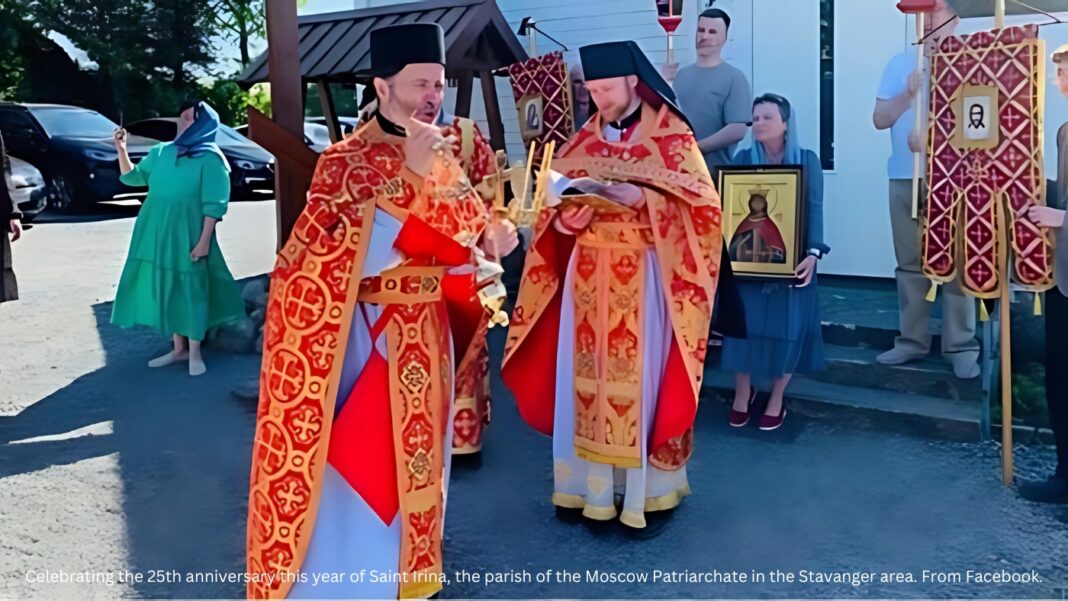Concern mounts about the increasing purchase of properties by the Russian Orthodox Church near military sites in Norway, which poses security issues.
In recent years, the Russian Orthodox Church (ROC) in Norway has acquired properties next to military bases, which has been a source of concern since the beginning of Putin’s war on Ukraine.
More than 700 religious communities receive state grants in Norway, including Orthodox parishes subordinated to Patriarch Kirill of Moscow and all Rus’ who blessed Russia’s war on Ukraine.
Purchase of properties
In 2017-2021, a number of properties were purchased by the ROC in the coastal area of Rogalan.
According to cadastral data, the ROC bought in 2017 a building in the town of Sherrey (Bergen community), located on a hill three kilometers away from Haakonsvern, which offers a view onto the main base of the Royal Norwegian Navy and the largest naval base in the Nordic area. Before the acquisition of this house, the religious community was located in the city center. The Orthodox priest in Bergen, Dimitry Ostanin, is Ukrainian and was appointed by Patriarch Kirill of Moscow and All Rus’ in 2008 when the Ukrainian Orthodox Church (UOC) was fully subordinated to him. Before that, he had served in Kaliningrad and Smolensk (Russia).
In the town of Stavanger, the former priest of the local community of the Russian Orthodox Church has a property near the NATO Joint Warfare Centre (JWC) in Jatta, according to Dagbladet. It is located just one kilometer away from an important military building, about fifteen minutes’ walk. That NATO Centre celebrated its 20th anniversary during a formal ceremony on 26 October 2023. Over the last two decades, the JWC has planned and delivered more than 100 exercises and training events and ensure that NATO’s commanders and their staffs are well-prepared and ready to respond to any mission, whenever and wherever the call may come.
The Russian Orthodox Church also has a parish in Trondheim. On 21 March 2021, the first Orthodox service in the city was celebrated for almost a thousand years as part of the celebrations of the feast of the Triumph of Orthodoxy at the parish of the Holy Princess Anna of Novgorod, in Russia. News of this important event in the life of Orthodox Christians in Norway was shown on the Russian The Saviour and Unity TV channels.
In 2015, the Russian Orthodox Church also bought a property in Kirkenes (Finnmark county) in the far north-east of Norway, on the border with Russia.
In addition, the Moscow Patriarchate sponsors work in Tromsø in northern Norway and in Svalbard, also known as Spitzbergen.
In 1996, the Moscow Patriarchate established a parish in Oslo. Among all Orthodox Churches in Norway, the parish of St. Olga in Oslo, is currently the largest one; another parish under the Moscow Patriarchate in the capital city is Saint Hallvard.
The presence of Orthodox Churches subordinated to the Russian Orthodox Church/ Moscow Patriarchate in EU countries has also raised national security concerns because in a number of cases they were suspected or accused of serving as relays for Putin’s propaganda or Russia’s spying activities. Czechia, Estonia, Lithuania, Sweden and Ukraine have taken various measures to anticipate or tackle security risks, including with the assistance of the Patriarchate of Constantinople.
In Norway, an Orthodox parish dedicated to St. Nicholas under the Patriarchate of Constantinople was founded in Oslo in 1931 by a small group of Russian refugees who fled the Bolshevik Revolution. In light of security threats attributed to the Russian Orthodox Church/ Moscow Patriarchate in several European countries, the ROC in Norway remains registered and surprisingly continues to receive state grants. One can wonder why Norway is so laxist with this security issue. Voluntary blindness or lack of political will or both?














 English
English French
French Spanish
Spanish German
German Dutch
Dutch Italian
Italian Danish
Danish Portuguese
Portuguese Greek
Greek Russian
Russian Swedish
Swedish Bulgarian
Bulgarian Hungarian
Hungarian Catalan
Catalan Ukrainian
Ukrainian Polish
Polish Basque
Basque Chinese (Simplified)
Chinese (Simplified) Japanese
Japanese Hebrew
Hebrew Arabic
Arabic Swahili
Swahili Amharic
Amharic Irish
Irish Afrikaans
Afrikaans Albanian
Albanian Armenian
Armenian Azerbaijani
Azerbaijani Belarusian
Belarusian Bengali
Bengali Bosnian
Bosnian Cebuano
Cebuano Chichewa
Chichewa Chinese (Traditional)
Chinese (Traditional) Corsican
Corsican Croatian
Croatian Czech
Czech Esperanto
Esperanto Estonian
Estonian Filipino
Filipino Finnish
Finnish Frisian
Frisian Galician
Galician Georgian
Georgian Gujarati
Gujarati Haitian Creole
Haitian Creole Hausa
Hausa Hawaiian
Hawaiian Hindi
Hindi Hmong
Hmong Icelandic
Icelandic Igbo
Igbo Indonesian
Indonesian Javanese
Javanese Kannada
Kannada Kazakh
Kazakh Khmer
Khmer Korean
Korean Kurdish (Kurmanji)
Kurdish (Kurmanji) Kyrgyz
Kyrgyz Lao
Lao Latin
Latin Latvian
Latvian Lithuanian
Lithuanian Luxembourgish
Luxembourgish Macedonian
Macedonian Malagasy
Malagasy Malay
Malay Malayalam
Malayalam Maltese
Maltese Maori
Maori Marathi
Marathi Mongolian
Mongolian Myanmar (Burmese)
Myanmar (Burmese) Nepali
Nepali Norwegian
Norwegian Pashto
Pashto Persian
Persian Punjabi
Punjabi Romanian
Romanian Samoan
Samoan Scottish Gaelic
Scottish Gaelic Serbian
Serbian Sesotho
Sesotho Shona
Shona Sindhi
Sindhi Sinhala
Sinhala Slovak
Slovak Slovenian
Slovenian Somali
Somali Sundanese
Sundanese Tajik
Tajik Tamil
Tamil Telugu
Telugu Thai
Thai Turkish
Turkish Urdu
Urdu Uzbek
Uzbek Vietnamese
Vietnamese Welsh
Welsh Xhosa
Xhosa Yiddish
Yiddish Yoruba
Yoruba Zulu
Zulu